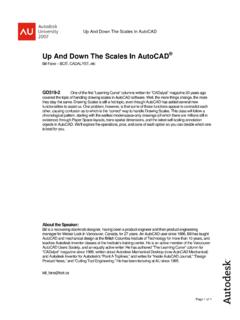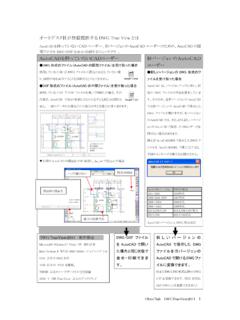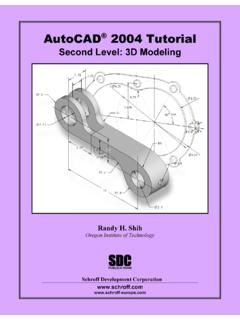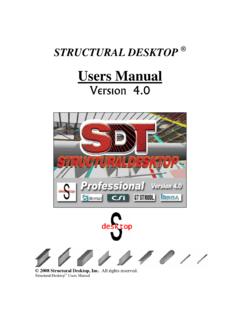Transcription of The Productivity Power of AutoCAD Tool Palettes …
1 The Productivity Power of AutoCAD tool Palettes Revealed! Matt Murphy - ACAD ventures GD215-4P There is more to tool Palettes than just a quick way to add blocks and hatch patterns to your drawing. Palettes provide the shortest, most efficient way to increase your Productivity without programming. In this session, you ll learn hidden techniques to migrate your standards, build custom commands, and create AutoCAD objects into powerful Content Tools. You'll also learn the secret of how to create and manage shared Palettes securely as an enterprise solution for your company standards. This session is for any user of AutoCAD from 2004 on, who wants to gain a comprehensive understanding of and full Productivity using AutoCAD tool Palettes .
2 About the Speaker: Matt has been recognized by Autodesk as a leader in providing professional training since 1985. He has served as an advisor and consultant to the training industry as chair of the Autodesk Training Center Advisory Board (ATCAB) and Executive Committee (ATCEC). Matt is also an Autodesk Approved Instructor (AAI) and a Certified Technical Trainer (CTT). He has received numerous instructional awards, including the ATC Eastern Regional Instructor of the Year for 2004. A widely acclaimed top trainer and featured columnist for CADalyst and AUGIW orld magazines, he has presented at Autodesk University for 14 years and was the top Autodesk University speaker in a large session for 2006. The Productivty Power of AutoCAD tool Palettes Revealed!
3 Introduction What are tool Palettes ? tool Palettes have been incorporated into AutoCAD since the 2004 releases. They were originally designed to provide an easy way to create, access and insert blocks and hatch patterns. Since Autodesk released the tool Palette Extension for AutoCAD 2004 and released AutoCAD 2005 there is now increased functionality such as Command Tools, Object Tools, Content Tools, Table Tools, Fly-outs, Palette Groups and true drag and drop creation from inside AutoCAD and outside AutoCAD with Microsoft directory sources. Why use tool Palettes ? Most users don t take the time or get the proper training to understand the Power of Palettes . But those who learn and apply Palettes become more productive. Most users will never go back to using pull-downs and toolbars.
4 The main benefits of tool Palettes are: 1. Easy customization without programming. 2. Palettes are also a great way to regain some of the screen real estate. Unlike toolbars, they can be docked, float, automatically hide and even be made transparent. 3. tool Palette tools can be organized or grouped into tabs. This avoids multiple toolbars or pull-downs. 4. tool Palettes make it easy to maintain company standards. They ensure accuracy and reduce rework due to items being drawn with the wrong color, layer, linetype, scale or style. 5. Finally, tool Palettes will make you more productive because you will now use fewer clicks and picks. Reducing repetitive steps, clicks and picks is how you become more productive working with AutoCAD . What I m about to show you are many popular and some little-known secrets of tool Palettes .
5 I guarantee that the techniques I will demonstrate will allow you to create a variety of tools that will make you more productive. SECRET REVEALED: When in doubt right-click! AutoCAD has many imbedded menus and features. Some are not as obvious as others. I always try to right-click on an object, menu or tab. This is especially true for a dialog box. As you shall soon see, there are many hidden features of tool Palettes . Understanding tool Palettes Let s first begin by looking at the tool Palette window. 2 The Productivty Power of AutoCAD tool Palettes Revealed! The tool Palette Window includes a title bar with several controls and individual tool Palettes . The controls for the tool Palette Window, the tool Palette and the tools on the palette as well as the properties of the tools are all controlled by a right-click.
6 Shown above are all the locations you can right-click to bring you into the pop-up control menu. Using the controls on the title bar, you can close the tool Palette Window and turn on auto-hide ( , roll it up when inactive), as well as making tool Palettes transparent. You can scroll through the block, hatch and command content of the sample tool Palette using either the scroll bar or the cursor. The cursor changes to a hand when it is not on a tool , allowing you to press, pan and scroll. You can also resize the tool Palette Window by stretching it along any corner. You can move the tool Palette to any location on your display or even outside the AutoCAD window by holding down the Ctrl key. Moving the palette to the left or right side of the AutoCAD window will allow it to automatically dock, if you select Allow Docking.
7 Transparency and Auto-hide are also controlled through the palette property. Since AutoCAD 2007 we can now Anchor Palettes so they take up less space than a toolbar! SECRET REVEALED: The palette window will also remain active when floating, even when the AutoCAD window is resized. (This tip will be helpful when you are creating content tools outside of the AutoCAD environment.) Working with tool Palettes Before you create your own tools, let s look more closely at the sample tools that come with AutoCAD . This way you ll learn how to build your own perfect beast! 3 The Productivty Power of AutoCAD tool Palettes Revealed! Loading the tool Palette Interface The tool Palette interface can be displayed by a variety of methods. You can turn the tool Palette window on or off from the Tools pull-down menu, the key combination Ctrl+3 or by the TOOLPALETTES or TOOLPALETTESCLOSE commands.
8 You can also use the TP command alias. Modifying an Existing tool Making a change to any existing tool is always the same, no matter what type of tool is being edited. All tools share the same common properties. Follow the steps below to edit a tool . Simply locate the tool that you want to edit on the tool Palette Window, right-click over the tool and select from the shortcut menu. Now you can change the Properties for the tool . Once you ve made the changes, click OK to accept the changes or Cancel to exit and ignore changes to the tool . You can change color, layer, linetype and lineweight properties as well as the object properties. Once changed, the tool will now function with the new properties for all future uses of the tool . Prior instances of the tool within the drawing will remain with the previous tool properties.
9 In other words it doesn t work like redefining a traditional Block. SECRET REVEALED: Renaming a tool does not redefine the tool . Changing the name under tool properties just makes the tool easy to identify on the palette. Making a Copy of an Existing tool You will notice that working with tool Palettes is a very familiar process. Autodesk has implemented Microsoft standards such as Cut, Copy and Paste. To make a copy of an existing tool , simply locate the tool that you want to edit on the tool Palette Window, right-click over the tool and select Copy from the shortcut menu, right-click again and select Paste. You can also select another tab that is part of your current tool Palette set and paste it to that tab. Moving a tool You can Cut a tool to remove it from one tool Palette and then Paste it to relocate it onto another tab in the tool Palette set.
10 The order of tools can be changed by holding down the left 4 The Productivty Power of AutoCAD tool Palettes Revealed! button on a tool while dragging it around on the current tab. You can tell where the tool will be relocated by the bold line that shows up in the tool Palette area as you hold the tool and move the cursor. Changing the Look tool Palettes can be represented with several different looks and each tab can independently have a different look. From the View Options dialog box you can change the image size and whether items are displayed with or without a description, and the View Options can be applied to the current palette or all Palettes . You can also apply a view to all Palettes , giving you consistency in the look and feel of the tools. To change the appearance of a tool Palette or a set of tool Palettes , simply select the tab that you want to change, right-click over the tab, or on an empty area of the tab, and select the View from the shortcut menu.






